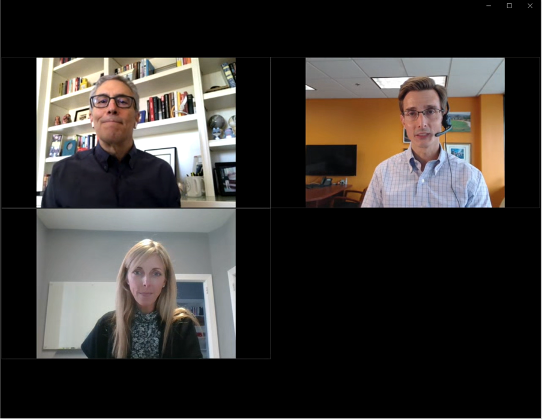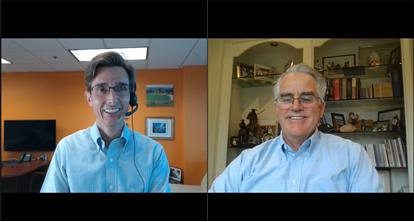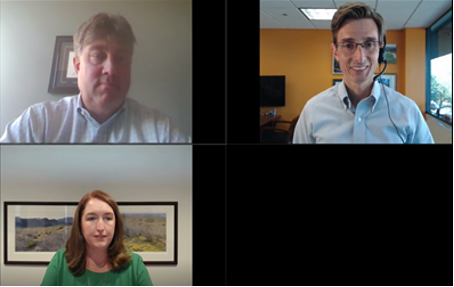Highlights from the 2020 Equity Methods Financial Reporting Symposium
2020 has been a year of firsts (and, we hope, a few lasts). One of those firsts was our virtual Financial Reporting Symposium, which we hosted in November after fielding numerous requests from our clients for this kind of event. About 75 controllers and directors of financial reporting joined us for two half-day sessions of topical peer-to-peer learning, keynote panel discussions, and networking. Here are the highlights.
Plenary Sessions
We had an outstanding lineup of guest speakers who offered their insights on financial reporting from three different perspectives: investors, the audit committee, and the CAO’s office.
View from Investors
Herb Greenberg of Pacific Square Research and Jessica Strine of Sustainable Governance Partners gave us a look into the world of investors and analysts. Why start with investors? Because these are the users of financial statements, the constituency financial reporting is serving—and it’s the quality of financial reporting in the US that makes ours the most robust and efficient capital market globally.
Herb unpacked different profiles of traditional investors, from players focused on fundamentals to passive investors like Vanguard. He shared the extensive process they use to flush out small changes in disclosure framing, relative differences among peers, and even slight but abnormal movements in key metrics.
Jessica dug deeper into the motivations of passive investors, who are often dubbed as having an investment horizon of “forever” and therefore do not buy or sell based on quarterly earnings. Environmental, social, and governance (ESG) criteria and long-run sustainability questions resonate with these investors. They’re also interested in whether management and the board have earned their social license to operate and are taking actions to ensure they exist in 10 or 20 years. Rewards and demerits are distributed through proxy voting, not short selling.
I asked about the SEC’s new human capital disclosure requirement and whether it’s workable to embed topics that lack clear standards and calculation methodologies into the 10-K. Is it even possible to cover such non-quantitative topics in the context of financial reporting? Jessica acknowledged that although many corporate social responsibility (CSR) reports are filled with “pretty pictures of flowers and polar bears and children blowing bubbles,” standards and reporting frameworks are rapidly emerging. Investors and institutions supporting market participants are maturing, in particular the Sustainability Accounting Standards Board (SASB) and Task Force on Climate-Related Financial Disclosures (TCFD).

View from the Audit Committee
If investors are studying every detail—even the CFO’s tone of voice on conference calls—audit committees are keeping an eye on the financial reporting process and underlying control environment. Joining us was Jim Barlow, the former CAO of Allergan and current audit committee chair at Arcturus Therapeutics. He’s also on the board of directors at NAHS Holding.
After covering the basics of what an audit committee does, we tackled some more nuanced topics. One was the best way to package information for the audit committee. Tips from Jim: Never sugarcoat, be transparent, avoid jargon, and break down complex topics—even for members with financial backgrounds.
What about the responsibilities that exist as a member of the overall board of directors—beyond the committee-specific responsibilities? They address issues like M&A, business development, innovation, risk, internal investigations, and talent.
Controllers with an interest in future board work should begin preparing today, according to Jim. Continue getting involved in operations, take a tour of duty through corporate development where M&A and other corporate actions are executed, and build bridges with senior management and the business lines.
Jim also covered some challenges accounting leaders face as they progress in their careers. One is reporting to the CFO and interacting with the CEO and business unit executives. Jim emphasized the importance of being “clear, concise, and logical.” When you need to say no, he said, do so candidly as a trusted advisor—but “say it combined with alternative solutions that can lead to a yes answer.”

View from the CAO’s Office
We also heard from two longtime friends of the firm, Don Zakrowski of Eli Lilly and Margaret Montemayor of Pioneer Natural Resources. They shared their views of what their top priorities as CAO have been, both generally and specifically to this pandemic-stricken year.
We began by discussing team dynamics during 2020, including the need to boost collaboration, video face time with colleagues, and short (but frequent) touchpoints. Although Lilly’s journey through the pandemic has been different from Pioneer’s, their top priorities are very similar. They include a focus on the control environment (especially when working remotely), equipping stakeholders with up-to-the-minute information, understanding the drivers of demand changes or supply shocks, and staying connected with investors and the questions they’re asking.
Our panelists also shared some of the biggest surprises of their roles, such as collaborating across functions. We touched on the importance of accounting functions being viewed as enablers of corporate strategy and not audit or “gotcha” functions.
Key stakeholder groups include IT, supply chain, HR, and of course the business lines. The focus must always be on understanding their goals and what they are trying to achieve, not simply what accounting needs from them. Looking for ways to help and be forthcoming with information may add to the team’s workload, but it earns accounting a seat at the table. This theme of being a trusted advisor resonated heavily between the audit committee and CAO panel.
We ended the session with a brief foray into ESG. The challenge that accounting functions face is that these newer metrics lack the objectivity of financial metrics—in part thanks to decades of GAAP that’s been drafted, revised, and battle-tested by thousands of companies over many years. Even so, accounting can make sure that disclosure items never outpace well-built calculation processes. They can also see to it that reported metrics run through accounting, with appropriate controls assigned to their production.

Peer-to-Peer Roundtable Discussion Sessions
Roundtable topics included upcoming 10-K disclosure rules on human capital management, automation and technology, internal controls, and segment reporting.
Human Capital Management (HCM) Disclosures
HCM, which is a subset of the broader ESG tailwind, was by far the most popular roundtable topic. Given that most corporations have calendar-year fiscal years, only a few attendees had actually been through the disclosure process—and their views were highly sought after.
A key part of the HCM discussion was about which internal function should own the disclosures. Some attendees said they expected accounting to own them, but with support and data from HR. Others said that HR should own it and simply rely on accounting for its core competence—controls and testing. There was no resolution and it seems like we’ll see both operating models in practice.
As we’ve written, who owns the process may matter less than ensuring all the right components exist. Those questions are: Is there a strategy on what to disclose and why? Are the calculations well-documented? What controls surround the calculations? Are there analytical reports that show changes over time and what drove those changes?
Given that the HCM disclosure may be simply the tip of the iceberg, one suggestion was to stand up a working group that focuses on disseminating ESG-related information through financial reporting. For example, for three years Intel has published in its 10-K a discussion of its six forms of capital, making it the front-runner in formally pointing shareholders to long-run non-financial considerations. This sort of working group should include representatives from legal, HR, accounting, and investor relations.
For most attendees, the primary struggle is information gathering, since data usually doesn’t live in a single place and isn’t necessarily even synchronized across systems. A parallel risk is the possibility that metrics would have to be computed manually—at a time when there are already too many error-prone manual processes. (This is one of the principal reasons accounting functions outsource key reporting to us. Manual processes not only break down over time, they’re limited in their ability to reveal and explain variance drivers.)
Systems, Technology, and Automation
It’s no secret that automation has been the mantra of many large organizations, as well as part of the departmental performance goals for most CAOs. Automation reduces risk, key-person dependence, and costs.
However, automation initiatives themselves can be costly. They also require high levels of cross-department buy-in and time commitment. For small and mid-cap companies in particular, the cost may seem to outweigh the perceived benefit. As a result, in a world of finite resources, automation ends up taking a back seat to other priorities where the benefits are more tangible.
Attendees traded a number of suggestions. First, prioritize based on impact and feasibility, keeping in mind that automation is a means to an end, not an end in itself. Next, candidly tackle questions such as where the most risk exists, like areas where a small number of people have too much tribal knowledge. Finally, understand that automation isn’t an either-or proposition. Often a process that is 80% automated is much safer than one that’s 20% automated.
We face these exact challenges within our practice, in which clients engage us to automate processes that are manual or semi-manual. We do have an advantage in that the people producing the automation are the subject-matter experts, which reduces timelines and the risk of losing key details in translation. However, normal automation processes involve needing to produce detailed documentation that is picked up by someone without domain expertise, giving rise to additional cost, timing, and friction. As a result, classic automation initiatives need to demonstrate a high benefit given the presence of many costs.
Some of the attendees from large-cap companies said they were experimenting with bots and other artificial intelligence (AI) technologies to complete routine tasks. One attendee emphasized the efficiencies he saw from building out an overseas shared services center. In short, there’s more than one way to approach automation and efficiency. The right answer will require considerable debate among a cross-functional team.
Internal Control over Financial Reporting (ICFR)
We addressed emerging trends in the design and deployment of controls in a COVID-19 environment. While participants were at very different steps before the pandemic hit, the push for paperless risk management is now affecting everyone. The silver lining is that the elimination of some longstanding and often inefficient processes became all but necessary in 2020.
Most participants shared that these newer, streamlined procedures would likely continue indefinitely—well past a return to the office. However, many were rolled out quickly, potentially with limited oversight. With teams stretched thinner than ever, there may not be time to circle back to these processes—most of which were stood up in mere months—and tidy up loose ends or perform much-needed documentation. Said differently, gains in efficiency have been largely offset by gains in complexity.
Disclosure Amid Uncertainty
COVID-19 has had a lasting impact on every industry. Some were disrupted, uprooted, and turned upside down. Others, especially in technology and life sciences, saw significant advancement. But all grappled with the best way to explain the effects of COVID-19 in their financial disclosures.
This might seem unnecessary for companies in industries that benefited. But their predicament is that investors may expect to see the earnings boost continue indefinitely. Will a pharmaceuticals company with a COVID-19 tailwind be able to sustain that momentum? At what point will the hypergrowth in certain technology companies begin to fade? These questions, and how to answer them for the street, would be simple if data on demand patterns existed. But it doesn’t—for many, nothing prior to 2020 pointed to what lay around the corner.
Non-GAAP is a related topic that has received considerable airtime over the past few years. The SEC has fought hard to ensure non-GAAP results cannot overshadow GAAP results; still, investors will focus on whichever metrics they consider most relevant. Most participants said they considered including COVID-19 repercussions in their non-GAAP disclosure but ultimately chose not to. The reason? It’s simply too hard to quantify consistently over time.
Other Topics
Segment reporting, leases, and revenue recognition also came up for discussion.
Competing views on when to report separate segments and how to apply the authoritative guidance led to some interesting debate. Many large companies continue to report a single segment, often to the awe of smaller companies that are already reporting two or more segments. Most expect to see additional guidance coming down the pike on this important disclosure topic. Meanwhile, discussions on adopting the new revenue recognition and lease guidance led to commiseration over the complexity and systems integration difficulties that dominated the last few years.
In 2021, we hope to do more events like the Financial Reporting Symposium, maybe covering a broader segment of the roles we work with (from different roles within accounting to total rewards and executive compensation). If you’re interested, please drop us a line.

